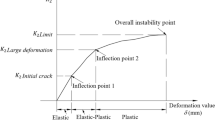Abstract
This paper proposes an improved dynamic stability analysis for abutment of dam (IDSAM) by combining interface boundary element with partitioned finite element (PFE-IBE). The total yield of the control area is taken as the instability criterion, and the area is made up of contact point pairs controlling the structural surface. The full structural surface yield state of the structural surface of the dam abutment rock mass was taken into account. The strength reduction coefficient corresponding to the full structural surface yield was taken as the safety factor of dam abutment stability. In this way, the damage of the structural surface can be reflected more accurately and intuitively, eliminating the impact of human factors on the valuation of the safety factor. Three calculation methods are used to evaluate the abutment stability of the Shapai Arch Dam, including pseudo-static method, the combination between finite element method and rigid body limit equilibrium method, and the proposed IDSAM. The comparison of results shows that the dam abutment safety factor obtained by IDSAM (left 2.4, right 3.0) ranges between those obtained by pseudo-static method (left 2.116, right 2.945) and finite element rigid body limit equilibrium method (left 2.429, right 3.182). Hence, the safety factor acquired by our method is rational. Considering the nonlinear characteristics of rock mass discontinuity, IDSAM reflects the operating state of the arch dam, shedding new light on the evaluation of aseismatic safety.








Similar content being viewed by others
Change history
09 April 2022
This article has been retracted. Please see the Retraction Notice for more detail: https://doi.org/10.1007/s12517-022-10079-5
28 September 2021
An Editorial Expression of Concern to this paper has been published: https://doi.org/10.1007/s12517-021-08472-7
References
Boyan Z, Houqun C, Jin T (2004) Improved FEM based on dynamic contact force method for analyzing the stability of arch dam abutment. J Hydraul Eng 35(10):7–12. https://doi.org/10.3321/j.issn:0559-9350.2004.10.002
Cai YE, Liang GP, Yin YQ (1998) A new numerical method modeling dynamic process of rockslides, in Proc. The 6th National Symposium of Geotechnical Mechanics Numerical Analysis with Analytic Method, Guangzhou, China, 73–79
Cundall PA (1988) Formulation of a three-dimensional distinct element model—Part I. A scheme to detect and represent contacts in a system composed of many polyhedral blocks. Int J Rock Mech Min Sci Geomech Abstr 25(3):107–116. https://doi.org/10.1016/0148-9062(88)92293-0
Ghaboussi J (1988) Fully deformable discrete element analysis using a finite element approach. Comput Geotech 5(3):175–195. https://doi.org/10.1016/0266-352X(88)90001-8
Hart R, Cundall PA, Lemos J (1988) Formulation of a three-dimensional distinct element model—Part II. Mechanical calculations for motion and interaction of a system composed of many polyhedral blocks. Int J Rock Mech Min Sci Geomech Abstr 25(3):117–125. https://doi.org/10.1016/0148-9062(88)92294-2
Kawai T (1977a) A new discrete model for analysis of solid mechanics problems. Journal of the Seisan Kenkyu 29(208-210):1977
Kawai T (1977b) New element models in discrete structural analysis. Journal of the Society of Naval Architects of Japan 1977(141):174–180. https://doi.org/10.2534/jjasnaoe1968.1977.174
Lei ZQ(2018) DDA analysis on creep deformation of slope triggered by reservoir impoundment. [Ph. D. Thesis] (Doctoral dissertation, Beijing City, China Institute of Water Resources &Hydropower Research)
Lemos J (1987) A distinct element model for dynamic analysis of jointed rock with application to dam foundation and fault motion [Ph. D. Thesis] (Doctoral dissertation, Twin Cities, MN: University of Minnesota)
Li XN, Shi R (2018, November) The dynamic stability analysis of Shapai Arch Dam affected by Wenchuan Earthquake. IOP Conference Series: Earth and Environmental Science 189(5):052020. https://doi.org/10.1088/1755-1315/189/5/052020
Li T, Liu X, Zhao L (2014) An interactive method of interface boundary elements and partitioned finite elements for local continuous/discontinuous deformation problems. Int J Numer Methods Eng 100(7):534–554. https://doi.org/10.1002/nme.4762
Li T, He J, Zhao L, Li X, Niu Z (2015) Strength reduction method for stability analysis of local discontinuous rock mass with iterative method of partitioned finite element and interface boundary element. Math Probl Eng:2015. https://doi.org/10.1155/2015/872834
Liu ZJ, Huang SP, Yang WF, Liu J (2019) Stability analysis about rock slop on toe slab of CFRD based on 3DEC. Chinese Journal of Underground Space and Engineering 15(Z2):966–977
Marx FA, Ernesto H, Marius BK, Valery D, Quirin A, Nicholas S, Edmond A (2018) Experiments and 3D DEM of triaxial compression tests under special consideration of particle stiffness. Geomaterials 8:39–62
Pang ML, Hu X, You L, Li JB (2017) Study on arch dam abutment stability of Mengdigou Hydropower Station. Chinese Journal of Underground Space and Engineering 13(6):1678–1687
Shi GH, Goodman RE (1985) Two dimensional discontinuous deformation analysis. Int J Numer Anal Methods Geomech 9(6):541–556. https://doi.org/10.1002/nag.1610090604
Shyu K, Salami MR (1996) Stability of bartlett dam. In Proceedings of the 1st International Forum on Discontinuous Deformation Analysis (DDA) and Simulations of Discontinuous Media, 440–446
Willam, K., Pramono, E., & Sture, S. (1989). Fundamental issues of smeared crack models. In Fracture of concrete and rock, 192–207. https://doi.org/10.1007/978-1-4612-3578-1_15
Xu YS (2020) Searching for critical sliding mode of arch dam abutment and anti-sliding sensitivity. Dalian University of Technology, Master's Thesis
Zhang C, Jin F, Xu YJ (2007) The dynamic analysis of arch dam-abutment stability. Journal of Hydroelectric Engineering 26(2):27–31
Zhang BY, Wang C, Li DY, Wang LT (2018) The research progress on seismic stability analysis of slopes in water conservancy and hydropower projects. Journal of China Institute of Water Resources and Hydropower Research 16:3,168–3,178
Zhuo JS, Zhao N (1993) Piecewise rigid body-interface spring method for problems of discontinuous medium. Journal of Hohai University 21(5):34–43
Funding
This work was supported by the National Natural Science Foundation of China (51809212, 51909137, 52009035).
Author information
Authors and Affiliations
Corresponding author
Ethics declarations
Conflict of interest
The authors declare that there are no conflicts of interest regarding the publication of this paper.
Additional information
Responsible Editor: Ahmed Farouk
This article is part of the Topical Collection on Big Data and Intelligent Computing Techniques in Geosciences
This article has been retracted. Please see the retraction notice for more detail:https://doi.org/10.1007/s12517-022-10079-5
About this article
Cite this article
Li, X., Li, T., Song, Z. et al. RETRACTED ARTICLE: Seismic stability analysis of arch dam abutment based on full structural surface yield method. Arab J Geosci 14, 844 (2021). https://doi.org/10.1007/s12517-021-07182-4
Received:
Accepted:
Published:
DOI: https://doi.org/10.1007/s12517-021-07182-4



